- JAPANESE
- LANGUAGE
X
 THAT IS GOOD
THAT IS GOOD
It’s like looking at a piece of concept art rather than a photograph. It’s humorous, but you can’t help but feel that the artist is trying to raise some kind of issue.
The third in our series of artist interviews is contemporary photographer Daisuke Matsumoto. This time, we talked with him about his background, the exhibition that starts on July 27th, and many more things.
DAISUKE MATSUMOTO solo Exhibition
【UNITED BY DISTORTION】
Period: July 27, 2021 (Tuesday) – August 2, 2021 (Monday)
Opening hours: 12:00 – 20:00
Location: “no-ma” at Shibuya PARCO
Address: Rise Building 1F, 13-17 Udagawa-cho, Shibuya-ku, Tokyo
Planning: TOKYO URBAN ART
This time (Part 1), we would like to ask about the backbone of his career as an artist.
Here we go!
-Please tell us how you started taking pictures.
I had a camera at home, and photography itself was very close to me since I was a child. I used to carry around a toy camera and a “Utsurun Desu” (Film with Lens, FUJIFILM), and I also took a toy camera of “Genius Bakabon” with me on school trips. At that time, I was not thinking of becoming a photographer in the future, but…
I guess I first became aware of it through record jacket photography. I used to be in a band, so I liked record jackets, especially early punk and hardcore, and I think that was my first inspiration.
My hometown is in rural areas in Tottori, so there was not much information available, and even if I read a music magazine, I could not actually get the CD. However, I always thought that this person was cool through magazines. I liked pictures of music, and through that, I came to know about *Koji Nomura, and through buying his photo books and reading interviews, I learned about *Hipgnosis and various keywords, and my knowledge expanded.
*Koji Nomura: Japanese photographer. He mainly works on CD jackets for musicians and magazine covers. He passed away in 2014.
*Hipgnosis: An English art design group that specialized in creating cover art for the albums of musicians and bands. Notable commissions included work for Pink Floyd, Led Zeppelin, among Japanese musicians, Yumi Matsutoya and Motoharu Sano.

-Please tell us about the things that formed your “self” in creating your work.
Comics and movies, I guess. I have more manga than photo books lol
When people ask me what my favorite manga is, I tell them ” The Ping-Pong Club ” by *Minoru Furuya lol
I like the serious side of Furuya Minoru’s work, like “Ciguatera”, but I like the gag side of his work. Especially up to “Boku to Issho”, which is gag-based but a bit serious.
I also like *Mochizuki Minetaro, and I like girls manga and *Weekly Shōnen Jump a lot. I’ll buy it again today and go home lol
*Weekly Shōnen Jump: The popular Japanese comic magazine and published weekly.
*Furuya Minoru and Mochizuki Minetaro are Japanese manga writers.
– You’ve got a wide range of genres, even from those girls comics!
But I’m not really a fan of American comics, and I guess I prefer ephemeral things rather than flashy ones. Shigeru Mizuki’s hometown is the same as mine, so I used to read his books at the library and so on, and somehow the darkness of yokai culture might have been rooted in my mind. After I moved to Tokyo, I realized that I grew up in a region called *”San’in” region, and as the Chinese character says, I have a dark character. On the contrary, like people in Hiroshima prefecture, which is known as the *”San’yo” region, are cheerful. That may be related to it.
*San’in is written as “山陰”. The word “陰” means shadow. Sanyo, on the other hand, is written as “山陽”. The word “陽” means sun.
– What kind of movies did you watch?
My mother was a big fan of special effects shows, so I often watched Ultraman, Godzilla, and Masked Rider.
The first time she took me to the theater was to see *“Ultra Q”. I was so scared that I cried a lot. The next week, I remember being taken to a Doraemon movie.
*UltraQ: This is a SF drama produced by Tsuburaya Productions, known for Ultraman.
It was inspired by foreign horror dramas, so it’s not really suitable for children…
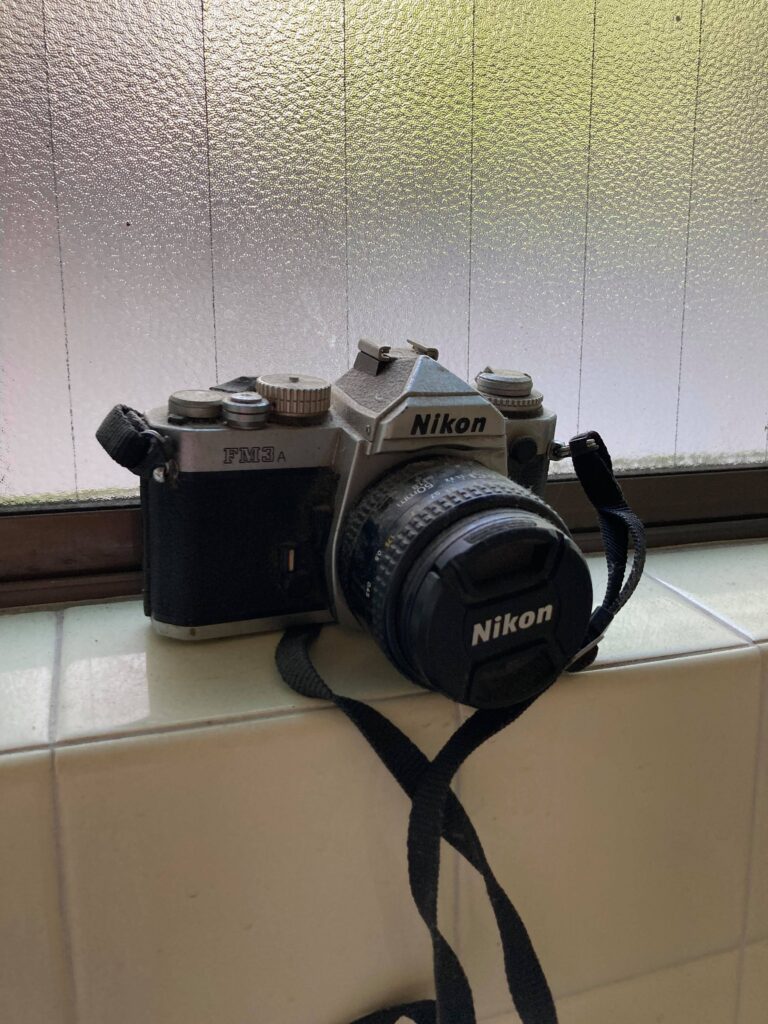
-When it comes to Tottori Prefecture, there is an image that this is the place where *Shoji Ueta was born. Does that have any influence on your background?
*Shoji Ueda: He was a photographer who worked in Tottori, Japan until his death. Although he called himself an amateur, his avant-garde directional photography was known throughout the world.
He was actually a neighbor of mine from the same neighborhood association, which I found out through studying photography. My grandfather and he used to chat at cafe and I used to meet him when my grandpa would leave me at his house, but I didn’t know anything about him at the time, so I just thought he was an ordinary old man in a camera shop.
By the way, the first time I bought a camera was at Mr. Ueda’s camera shop, and since I didn’t know how to choose a camera at that time, I decided right away to buy this one. (Then his daughter who was working at the store) said to me, “That’s so cool!“ lol
-The story so far is full of episodes where it seems like you were meant to be a photographer, but did you do any specialized study after that?
I was aiming for an art school, but I failed…. In the end, I entered a commercial school, but it was boring, so I dropped out. It was a small town, so I could hang out with my new friends without having to go to school, and I thought it was a waste of time to spend on something I wasn’t interested in. After that, a friend of mine who was in the photography club told me about a vocational school in Osaka that allowed me to carry out my studies without needing to have a valid altitude school diploma, and I decided to go there.
-Do you have any impressive memories from your time at your vocational school?
The school was different from an art college in that it was not an academic school and many of the students were second generation photography studio owners. At that time, I was shooting black and white film, and perhaps because of this, my student life was such that I would only go to school to develop film, and I would make work but not submit any assignments.
This is different from the way I work now. When did you start to develop your style?
At first, I was taking documentary snaps. I carried my camera around with me and was always taking pictures. When I was 19 or 20 years old, I started to take pictures after deciding on a concept or picture for my graduation project.
When I was printing in black and white, my work tended to be like that of Daido Moriyama and many people around me were also doing that kind of work. So I thought, “Let’s do something no one else is doing!” lol
*Daido Moriyama: A photographer. He has brought “rough, blurred and out-of-focus.” into photography, which is supposed to be a challenge to take clearer pictures, and has shocked the world of photographic expression.
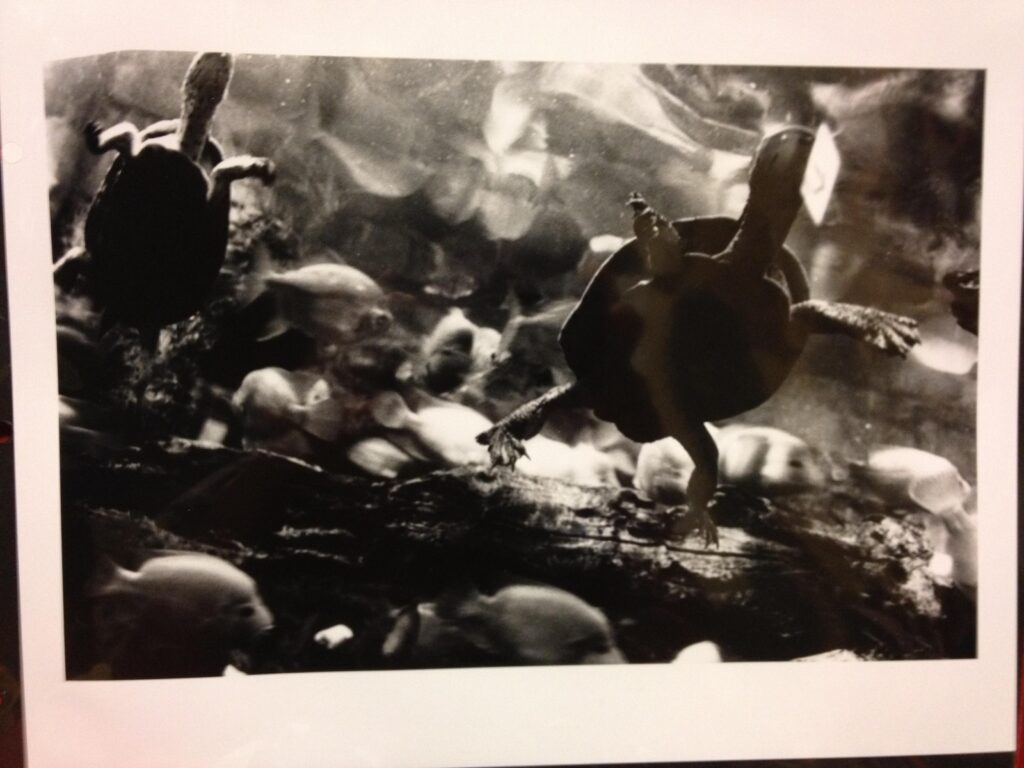
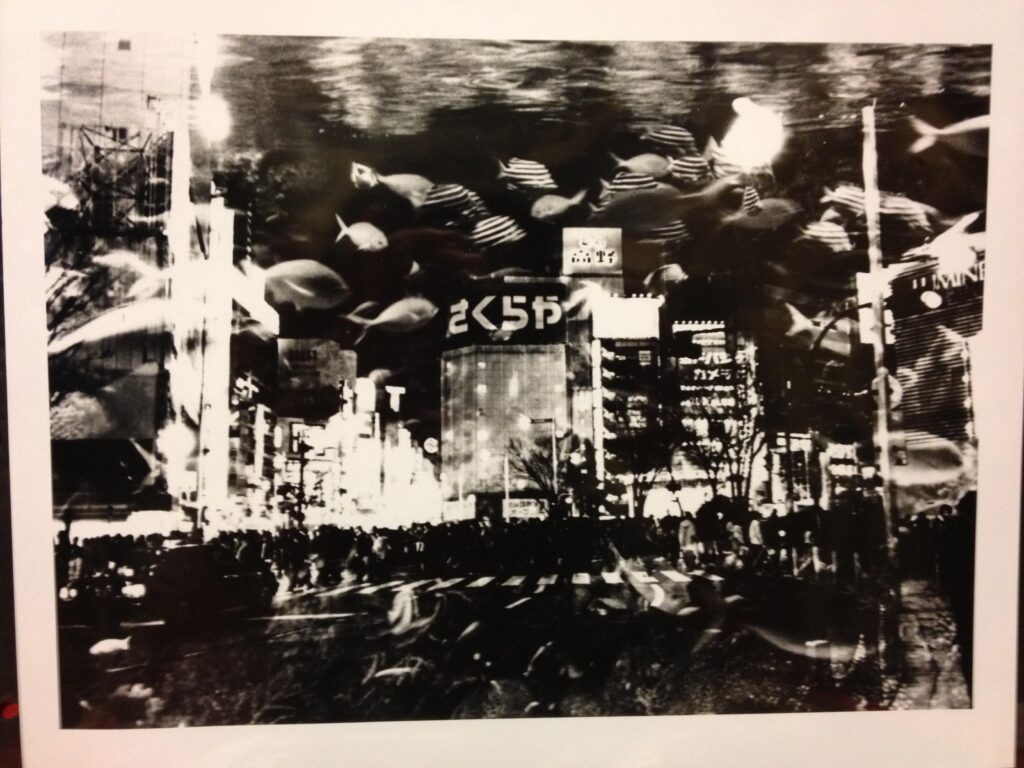
I asked him to send me a photo from his school days.
It’s clear that the image is completely different.
-The current strategy is one that feels like a skit, but also has an emotional message. What was your work like when you made the switch?
First of all, in terms of contrast, the influence of “Downtown no Gottsu Ee Kanji” is huge….
*Downtown no Gottsu Ee Kanji: a Japanese variety show.
The first time I did the mask series was for Ultraman and Godzilla, and from there I switched to digital and color work. When a friend of mine from childhood who is a painter saw my work, and told me it was too cool. That made me angry, so I decided to do whatever I wanted lol
-That’s when you came up with the idea of having Ultraman and Godzilla fight each other lol
After that, when a group exhibition was held in Tokyo, the main focus was on another type of work, but I placed one part of the work on the corner and the reaction was good, so I submitted it to a competition and won a prize.
From there, I was able to display my work in galleries and publish photo books.
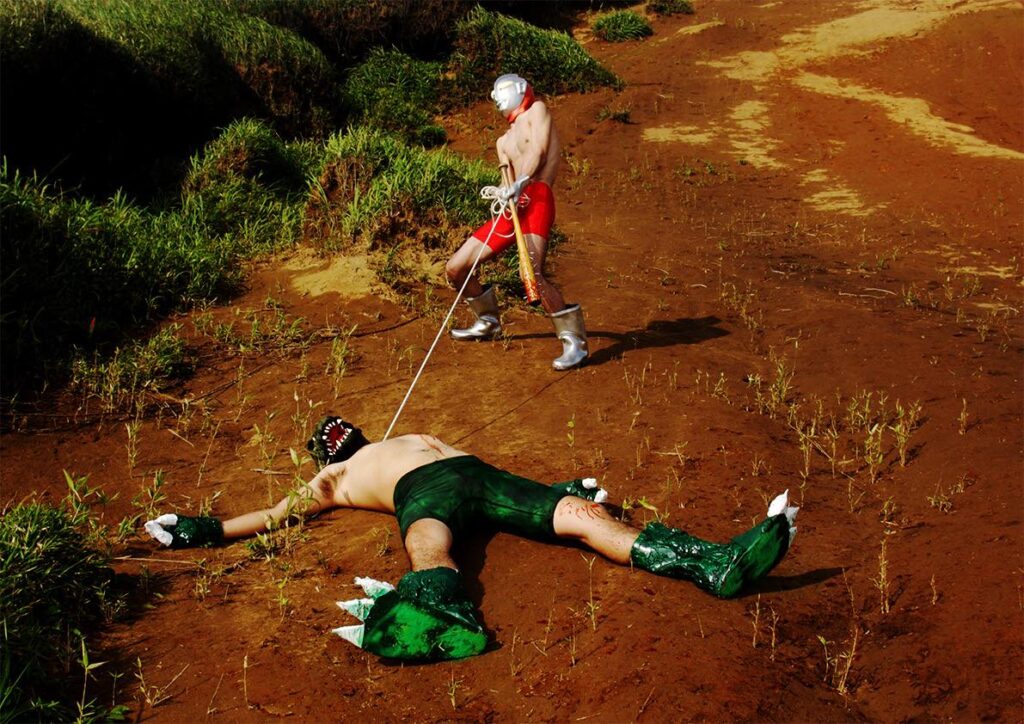
-For me personally, the picture of Donald from McDonald’s was very meaningful and had a strong impact. Do you have any special intentions for this?
I don’t mean to be cynical, but… (silent for a while) No, I’d say there is, but when I was thinking about what to do, the character of Ronald McDonald came to mind, and then the phrase “100% beef” came to mind. On the other hand, at that time there was an urban myth that patties were made from worms, wasn’t there?
I thought it would be a great idea to have a story about Donald hunting a minotaur, even though it is a minotaur. I wanted to do it in a green meadow, but it was snowing, but I still decided to do it, and the model got frostbite, so it was very tough…lol
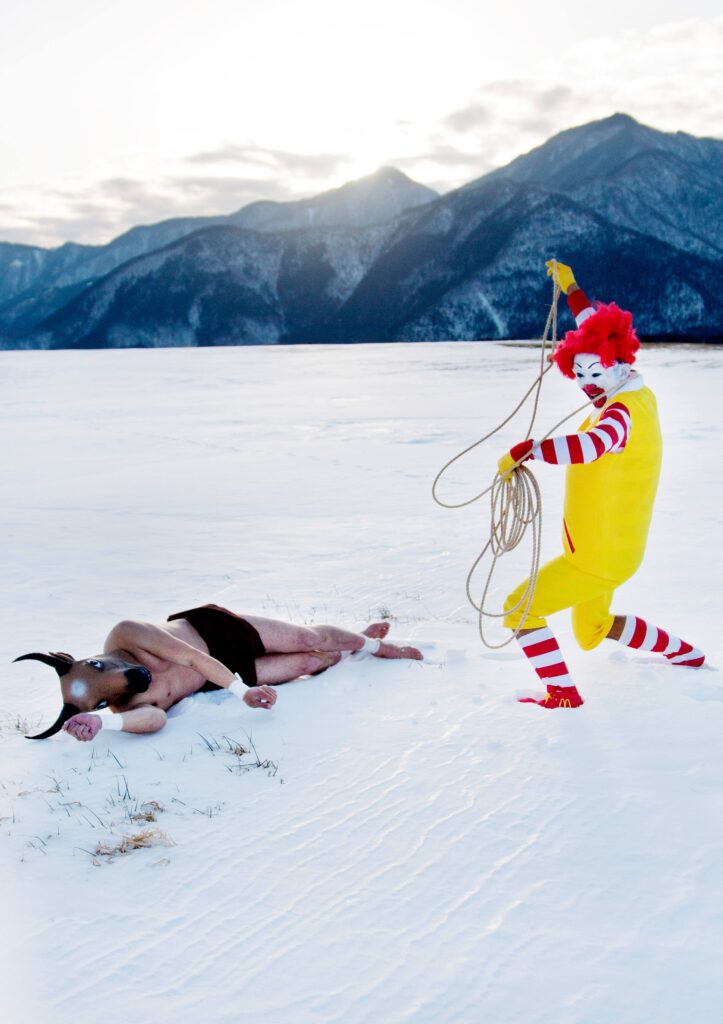
-We might be eating a minotaur… And that’s why it was in a snowfield lol
This is quite a striking work for first viewers. How did you get your inspiration?
I guess I like to think of stories in the first place. Also…I can come up with them in a flash…
In the process of creating the work, I look into things in order to put the ideas into perspective, and strengthen the evidence. I don’t try to do something socially, but I start with a picture or an idea and go from there. It’s a way of adding more context to the work, such as the contemporary situation and the history of art. That process is much more time consuming than shooting.
Next, we focused on the unconventional work “SOULS”, which is transmitted through the expression of publishing. We’ve seen the websites that introduce SOULS, but we couldn’t get a clear picture of this unknown medium from there!
-Can you tell me about the SOULS that you publish yourself?
I decided to take people who will be even more interesting in the next 20 or 30 years. But since I’m a photographer, it’s not like an interview, so I asked them to write a text and use it as an inspiration to take pictures.


Instagram→@SOULS_tokyo
A part of “SOULS”. It’s a medium that you can easily purchase, so please follow the information on Instagram!
I think the form of *online printing at 7-Eleven is unique, but why did you take this form? What is the reason for this form?
*You can print photos and documents from multi-printer at the Convenience Store like 7-Eleven in Japan.
At first, I tried to put up free papers in various places, but it became difficult at Corona pandemic, so I decided to use Seven-Eleven’s online printing service. You can find Seven-Eleven stores all over Japan. Well, the Seven-Eleven in my hometown in Tottori prefecture was the last one to open in Japan lol But you can still read the magazine in Tottori and my friends in my hometown are also enjoying it.
Also, I wanted to fit it into the pocket size of a paperback book, for example, while waiting for a train or in a gap in the life of the reader.
-Is there a reason why you didn’t go with the web version?
Somehow, I thought it would not make sense if it could be easily viewed on the web. I think the approach that lies between analog and digital, using online printing and coming out in paper, is what I want to do.
There’s a difference between the context of just watching something on a timeline and the context of buying and reading a book. Buying a book means the recipient is prepared to see it. That’s why I wanted it to be physical and not just be on the web.
-So, there is a meticulous planning. It made a lot of sense to me.
By the way, how did you come up with the idea of publishing this book?
When I was a teenager, I bought a thick book of portraits by Daisuke Iga called “First time – Daisuke Iga・MOTOKO” because it had some of my favorite musicians in it.
When I read it again a few years later, and a few years after that, I found myself thinking, “What? I didn’t know there were any people in the book?” It’s a new revelation when you look at it after you’ve gained knowledge and experience. For example, *Makoto Aida is actually in the magazine, which I didn’t know at the time.
So I realized that I needed to take pictures of the people I have been playing with. I thought that just copying or taking portraits was not the way to go, and as a result, the content became what it is today.
*Makoto Aida: A Japanese contemporary artist. He creates works with extreme themes, such as grotesqueness and eroticism etc. He is always producing sensational topics.
–The introductory text I saw on the website said that the magazine would also feature elementary school students, while also featuring GEZAN’s MahiToThePeople, the Seppuku Pistols, and other up-and-coming artists but is there actually an article on elementary school students?
I have a friend’s kid named Ryu, and I’ve been asking him to write, but he won’t do it lol
Since he was a little kid, he’s been coming into the live houses and art galleries where we play, and everyone loves him, so we teach him everything, including DJing, guitar, and how to make coffee. That’s why the other day I asked him what he was interested in and he answered, “Space.” lol
-He’s very mature and already reached that level…lol It’s definitely worth featuring, and it’s probably the one I’d like to see the most!
In a good way, the kids are the ones who think the craziest, aren’t they? But maybe because they were pushed around by adults, they don’t fit in well with their classmates. He is reclusive and doesn’t write well, so he is now a junior high school student. Now he’s going through adolescence lol
I’m looking forward to seeing Ryu’s messages and photos as he enters adolescence, as it will definitely be a highlight content for SOULS. Personally, I would like to feature him as the epitome of subculture in “THAT IS GOOD”, the Japanese culture channel! we are waiting for him!
Aside from the joke, storing physical media such as magazines can be used not only as an archive of information, but also as a point to weave new lines, and can be used for a lifetime.
When it comes to the web, I wonder if information is drowned in the sea of information or not. I think this sense of value is changing, but I still think that magazines are strong because they have a physical body. I hope that THAT IS GOOD will play a similar role for those who read it (even though it is a web media).
The vision for the future of SOULS is to publish a book at the time when it has reached about 100 people.
-On a different topic, I saw a video on vimeo of you talking about your work, and it was surprising to hear you say that you don’t enjoy photography. Do you still feel the same way? (On the other hand, you also made the remark “but still the best”.)
What? Is there a video that says that? lol
I think it was a long time ago, but well, taking pictures is not fun. There was never a moment when I thought, “Oh… photography is fun!”
But when I get reactions from people who see my photos, I get excited.
But it’s definitely more fun when I’m just playing lol
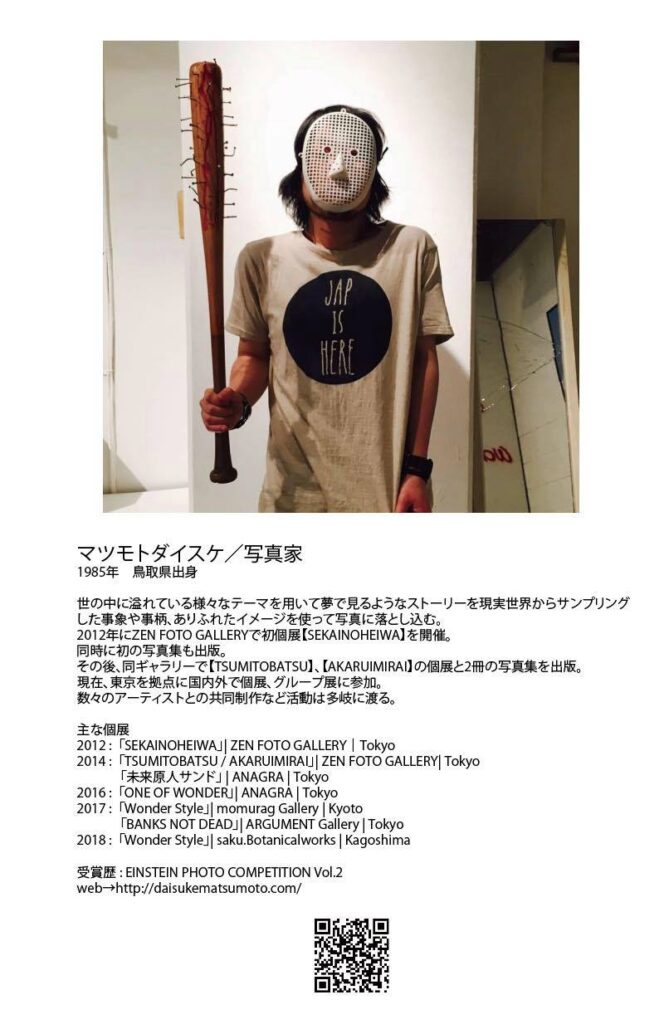
Daisuke Matsumoto / Photographer
Born and raised from Tottori in 1985.
Using a variety of themes that abound in the world, he incorporates dreamlike stories into his photographs using events sampled from the real world and commonplace images.
In 2012, he held his first solo exhibition “SEKAINOHEIWA” at ZEN FOTO GALLERY.
He also published his first photo book.
Since then, he has held solo exhibitions of “TSUMITOBATSU” and “AKARUIMIRAI” at the same gallery, and published two photo books.
Currently based in Tokyo, he has participated in solo and group exhibitions in Japan and abroad.
He has collaborated with many artists in a wide range of activities.
So that was the first part of the interview with Daisuke Matsumoto.
Maybe it’s just a coincidence, but most of the people I’ve interviewed have said that drawing is fun! It was interesting to hear such an interesting perspective.
I felt that Daisuke Matsumoto’s art is the very north of contemporary photography, as he develops an unconventional worldview within the genre of photography while forming his work in a social context.
In the second part of this article, we will report on the episodes of the exhibition that will be held in the near future, but in the next article, we will explore his worldview in more depth, and the contents will be quite extreme. What are you capturing through his camera? What does he want to convey? Let’s take a closer look at one part of the story.
TEXT : THAT IS GOOD editorial department, Koga